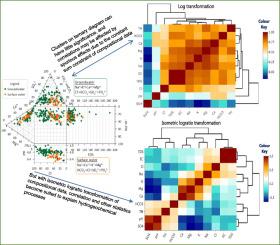Journal of Geochemical Exploration ( IF 3.4 ) Pub Date : 2021-02-03 , DOI: 10.1016/j.gexplo.2021.106737 Ugochukwu Ewuzie , Innocent C. Nnorom , Ositadinma Ugbogu , Chibuzo V. Onwuka

|
Surface and groundwaters are the major sources of drinking and irrigation water in most developing countries. Hydrogeochemical data, being compositional in nature require adequate statistical treatment in order to provide dependable information needed for decision making. In this study, water samples were collected from 100 groundwaters and 24 surface waters within the principal Benin and Bende-Ameki lithostratigraphic units in Southeastern Nigeria, and analyzed for major ions, microbiological and other physicochemical parameters using standard methods. An approach based on the isometric logratio (ilr) transformation, leading to the ostensible symmetric coordinates was applied for multivariate statistics. Source ‘fit for purpose’ for drinking and irrigation was assessed using a modified water quality index (WQI), TDS-pE graph, sodium hazard (SAR), magnesium hazard (MAR), and other ionic models. Most surface and groundwater sources were acidic with 84% and 98% of the samples respectively having pH below WHO permissible limit for drinking water. Compositional data (CoDa) analysis produced robust principal components (PCs) and clusters that were key in explaining important hydrogeochemical processes in the water sources, whereas heatmaps of the correlated variables clearly showed how spurious effects due to the constant sum constraint of compositional data could occur using non-CoDa statistical approaches. The first two PCs of surface and groundwater data explained 74.8% and 67.0% of the total variance respectively, which indicated relative dominance of SO42− and HCO3− respectively. Results showed that all surface water sources were suitable for irrigation by SAR, MAR, Mg:Ca, and Wilcox method, whereas some groundwater sources were unsuitable. TDS-pE graph and WQI classified water sources as “excellent”, with the former being simple and generic for instant monitoring of water quality. More so, minimal treatment is recommended to meet the microbial criteria for domestic use of the water sources.










































 京公网安备 11010802027423号
京公网安备 11010802027423号